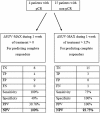Early prediction of histopathological response of rectal tumors after one week of preoperative radiochemotherapy using 18 F-FDG PET-CT imaging. A prospective clinical study
- PMID: 22853868
- PMCID: PMC3447722
- DOI: 10.1186/1748-717X-7-124
Early prediction of histopathological response of rectal tumors after one week of preoperative radiochemotherapy using 18 F-FDG PET-CT imaging. A prospective clinical study
Abstract
Background: Preoperative radiochemotherapy (RCT) is standard in locally advanced rectal cancer (LARC). Initial data suggest that the tumor's metabolic response, i.e. reduction of its 18 F-FDG uptake compared with the baseline, observed after two weeks of RCT, may correlate with histopathological response. This prospective study evaluated the ability of a very early metabolic response, seen after only one week of RCT, to predict the histopathological response to treatment.
Methods: Twenty patients with LARC who received standard RCT regimen followed by radical surgery participated in this study. Maximum standardized uptake value (SUV-MAX), measured by PET-CT imaging at baseline and on day 8 of RCT, and the changes in FDG uptake (ΔSUV-MAX), were compared with the histopathological response at surgery. Response was classified by tumor regression grade (TRG) and by achievement of pathological complete response (pCR).
Results: Absolute SUV-MAX values at both time points did not correlate with histopathological response. However, patients with pCR had a larger drop in SUV-MAX after one week of RCT (median: -35.31% vs -18.42%, p = 0.046). In contrast, TRG did not correlate with ΔSUV-MAX. The changes in FGD-uptake predicted accurately the achievement of pCR: only patients with a decrease of more than 32% in SUV-MAX had pCR while none of those whose tumors did not show any decrease in SUV-MAX had pCR.
Conclusions: A decrease in ΔSUV-MAX after only one week of RCT for LARC may be able to predict the achievement of pCR in the post-RCT surgical specimen. Validation in a larger independent cohort is planned.
Figures




Similar articles
-
Early prediction of histopathological response of locally advanced rectal cancer after 1 week of preoperative radiochemotherapy using 18FDG PET-CT imaging: a prospective clinical validation study.Radiat Oncol. 2025 Aug 1;20(1):121. doi: 10.1186/s13014-025-02703-x. Radiat Oncol. 2025. PMID: 40751160 Free PMC article.
-
Predicting pathological response to neoadjuvant chemoradiotherapy in locally advanced rectal cancer using 18FDG-PET/CT.Ann Surg Oncol. 2012 Jul;19(7):2178-85. doi: 10.1245/s10434-012-2248-z. Epub 2012 Mar 7. Ann Surg Oncol. 2012. PMID: 22395978
-
The predictive role of sequential FDG-PET/CT in response of locally advanced rectal cancer to neoadjuvant chemoradiation.Am J Clin Oncol. 2012 Aug;35(4):340-4. doi: 10.1097/COC.0b013e3182118e7d. Am J Clin Oncol. 2012. PMID: 21422901
-
The efficiency of 18F-FDG-PET/CT in the assessment of tumor response to preoperative chemoradiation therapy for locally recurrent rectal cancer.BMC Cancer. 2021 Oct 21;21(1):1132. doi: 10.1186/s12885-021-08873-7. BMC Cancer. 2021. PMID: 34674666 Free PMC article.
-
Sequential FDG-PET and induction chemotherapy in locally advanced adenocarcinoma of the Oesophago-gastric junction (AEG): the Heidelberg Imaging program in Cancer of the oesophago-gastric junction during Neoadjuvant treatment: HICON trial.BMC Cancer. 2011 Jun 24;11:266. doi: 10.1186/1471-2407-11-266. BMC Cancer. 2011. PMID: 21702914 Free PMC article.
Cited by
-
Predicting complete response to neoadjuvant CRT for distal rectal cancer using sequential PET/CT imaging.Tech Coloproctol. 2014 Aug;18(8):699-708. doi: 10.1007/s10151-013-1113-9. Epub 2014 Feb 8. Tech Coloproctol. 2014. PMID: 24509716 Clinical Trial.
-
Recent chemotherapy reduces the maximum-standardized uptake value of 18F-fluoro-deoxyglucose positron emission tomography in colorectal cancer.Gut Liver. 2014 May;8(3):254-64. doi: 10.5009/gnl.2014.8.3.254. Gut Liver. 2014. PMID: 24827621 Free PMC article.
-
Circulating serum microRNA-345 correlates with unfavorable pathological response to preoperative chemoradiotherapy in locally advanced rectal cancer.Oncotarget. 2016 Sep 27;7(39):64233-64243. doi: 10.18632/oncotarget.11649. Oncotarget. 2016. PMID: 27572313 Free PMC article.
-
Visualization, imaging and new preclinical diagnostics in radiation oncology.Radiat Oncol. 2014 Jan 3;9:3. doi: 10.1186/1748-717X-9-3. Radiat Oncol. 2014. PMID: 24387195 Free PMC article. Review.
-
The predictive value of 18F-FDG PET/CT for assessing pathological response and survival in locally advanced rectal cancer after neoadjuvant radiochemotherapy.Eur J Nucl Med Mol Imaging. 2015 Apr;42(5):657-66. doi: 10.1007/s00259-014-2820-9. Epub 2015 Feb 17. Eur J Nucl Med Mol Imaging. 2015. PMID: 25687534
References
-
- Kapiteijn E, Marijnen CA, Nagtegaal ID, Putter H, Steup WH, Wiggers T, Rutten HJ, Pahlman L, Glimelius B, van Krieken JH, Leer JW, van de Velde CJ. Dutch Colorectal Cancer Group. Preoperative radiotherapy combined with total mesorectal excision for resectable rectal cancer. N Engl J Med. 2001;345:638–646. doi: 10.1056/NEJMoa010580. - DOI - PubMed
-
- Sauer R, Becker H, Hohenberger W, Rödel C, Wittekind C, Fietkau R, Martus P, Tschmelitsch J, Hager E, Hess CF, Karstens JH, Liersch T, Schmidberger H, Raab R. German Rectal Cancer Study Group. Preoperative versus postoperative chemoradiotherapy for rectal cancer. N Engl J Med. 2004;351:1731–1740. doi: 10.1056/NEJMoa040694. - DOI - PubMed
-
- Valentini V, Coco C, Cellini N, Picciocchi A, Fares MC, Rosetto ME, Mantini G, Morganti AG, Barbaro B, Cogliandolo S, Nuzzo G, Tedesco M, Ambesi-Impiombato F, Cosimelli M, Rotman M. Ten years of preoperative chemoradiation for extraperitoneal T3 rectal cancer: Acute toxicity, tumor response, and sphincter preservation in three consecutive studies. Int J Radiat Oncol Biol Phys. 2001;51:371–383. - PubMed
-
- Capirci C, Rubello D, Chierichetti F, Crepaldi G, Fanti S, Mandoliti G, Salviato S, Boni G, Rampin L, Polico C, Mariani G. Long-term prognostic value of 18 F-FDG PET in patients with locally advanced rectal cancer previously treated with neoadjuvant radiochemotherapy. Am J Roentgenol. 2006;187:W202–W208. doi: 10.2214/AJR.05.0902. - DOI - PubMed
MeSH terms
Substances
Supplementary concepts
LinkOut - more resources
Full Text Sources

